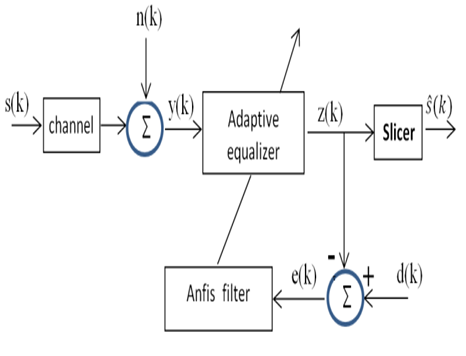Adaptive Equalization for UWB communication System based on ANFIS
Main Article Content
Abstract
Ultra-wideband (UWB) communication systems cover enormous bandwidths that have strongly low-power spectral densities. At UWB communication system with high data rate, owing to multipath propagation, the spread delay in inter symbol interference (ISI) will raise the bit error rate (BER) considerably. ISI which is formed via the UWB channels can be removed by equalization, which is one of the most significant signal processing techniques. Furthermore, LMS algorithm represents a very efficient tool for determining adaptive equalizer coefficients values in communication systems, in spite of that, the LMS adaptive equalizer encounters response diminishing besides slow convergence rate. The current paper adopts an adaptive equalizer based adaptive neuron-fuzzy inference system (ANFIS). The simulation outcomes reveal that the convergence rates as well as accuracy of identification of ANFIS based algorithm are surpass the traditional LMS algorithm, moreover, simulation outcomes prove that ISI is effectively limited and the performance of the system is clearly improved.
Article Details
References
J. Dong, Z. Lian, J. Xu, and Z. Yue, "UWB Localization Based on Improved Robust Adaptive Cubature Kalman Filter," Sensors vol. 23, no. 5 (2023) 2669, doi:10.3390/s23052669
V. B. Raskar ,S. L. Lahudkar, " Performance Comparison of TR and FSRUWB System Using Particle Filter: Effects of Frequency, Data Rate, Multi-Path and Multi-Channel Communication," International Journal on Recent and Innovation Trends in Computing and Communication vol. 10 no. 2s (2022), Pp. 269–280, doi.org/10.17762/ijritcc.v10i2s.5943.
A. M. Ali, R. S. A. R. Abdullah, S. J. Hashim, M. F. A. Rasid, A. Sali, A. Ismail, and F. Hashim, "Experimental investigation of UWB signal interference effect between UWB communication device and VSAT," Jurnal Teknol vol. 82, no. 1 (2020): pp. 115-124, doi: 10.11113/jt.v82.13866
K. Guo, Z. Qiu, C. Miao, A. H. Zaini, C. Chen, W. Meng, and L. Xie, "Ultra-wideband-based localization for quadcopter navigation," Unmanned Systems vol. 4, no. 01 (2016): pp. 23-34, doi: 10.1142/S2301385016400033
R. Wongsathan and P. Supnithi, "Fuzzy logic?based adaptive equaliser for non?linear perpendicular magnetic recording channels," IET Communications vol. 13, no. 9 (2019): pp. 1304-1310 , doi: 10.1049/iet-com.2018.5815
Y. F. Wang, "Adaptive rake receiver joined with chip equalization for DS-CDMA UWB systems over ISI channels," Procedia Engineering 29 (2012): pp. 3768-3773, doi:10.1016/j.proeng.2012.01.568
P. K. Mohapatra, S. K. Rout, S. K. Bisoy, and M. Sain, "Training Strategy of Fuzzy-Firefly Based ANN in Non-Linear Channel Equalization." IEEE Access 10 (2022): pp. 51229-51241, doi:10.1109/ACCESS.2022.3174369
C. Krall, K. Witrisal, H. Koeppl, G. Leus, and M. Pausini, "Nonlinear equalization for frame-differential IR-UWB receivers," In 2005 IEEE International Conference on Ultra-Wideband, pp. 576-581, doi:10.1109/ICU.2005.1570052
Y. H. Ng, H. Mohamad, and T. C. Chuah, "Subband adaptive chip equalization for interference suppression in DS-UWB," IEICE Electronics Express vol. 4, no. 5 (2007): pp. 153-158, doi: 10.1587/elex.4.153
H. O. P. Sahu, and S. Kumar, "A new channel equalizer using adaptive neuro fuzzy inference system," IETE Journal of Research vol. 57, no. 3 (2011): pp. 201-206, doi: 10.4103/0377-2063.83640.
M. Miry, A. Miry, and H. Khleaf, "Adaptive noise cancellation for speech employing fuzzy and neural network," In 1st International Conference on Energy, Power and Control (EPC-IQ), pp. 289-296. IEEE, 2010, Retrieved from https://ieeexplore.ieee.org/abstract/document/5767329
T. Çavdar, "PSO tuned ANFIS equalizer based on fuzzy C-means clustering algorithm." AEU-International Journal of Electronics and Communications 70, no. 6 (2016): pp. 799-807, doi: 10.1016/j.aeue.2016.03.006
C. GC, M. Y. Alias, and C. TC, "An adaptive minimum bit-error decision-feedback equalizer for UWB systems," IEICE Electronics Express vol. 4, no. 14 (2007): pp. 435-441, doi: 10.1587/elex.4.435
N. S. Bakinde, X. Zhu, J. Gao, A. K. Nandi, and H. Lin, "Genetic algorithm based equalizer for ultra-wideband wireless communication systems." IEICE transactions on communications vol. 93, no. 10 (2010): pp. 2725-2734,doi: 10.1587/transcom.E93.B.2725
A. Parihar, L. Lampe, R. Schober, and C. Leung, "Equalization for DS-UWB systems—part I: BPSK modulation." IEEE Transactions on Communications vol. 55, no. 6 (2007): pp. 1164-1173, doi:10.1109/TCOMM.2007.898836
D. Kundu, and G, Nijhawan, "Performance analysis of adaptive channel equalizer using LMS, various architecture of ANN and GA,"International Journal of Applied Engineering Research vol. 12, no. 22 (2017): pp. 12682-12692. Retrieved from http://ripublication.com/ijaer17/ijaerv12n22_126.pdf
A. H. Mary, miry and M. H. Miry, "ANFIS based reinforcement learning strategy for control a nonlinear coupled tanks system." Journal of Electrical Engineering & Technology vol. 17, no. 3 (2022): pp.1921-1929, doi 10.1007/s42835-021-00753-1
A. Raj, and Dejey, "Adaptive neuro-fuzzy inference system-based nonlinear equalizer for CO-OFDM systems." The Computer Journal vol. 63, no. 2 (2020): 169-178, doi 10.1093/comjnl/bxz072
A. Miry, A. Hussien, and M. Miry, "Mixed robust controller with optimized weighted selection for a DC servo motor." In Proceedings of the International Conference on Information and Communication Technology, pp. 178-183. 2019, doi:10.1145/3321289.3321304
S. Yahya, A. Rezaei, and R. I. Yahya, "A new ANFIS-based hybrid method in the design and fabrication of a high-performance novel microstrip diplexer for wireless applications." Journal of Circuits, Systems and Computers vol. 31, no. 03 (2022): 2250050, doi:10.1142/S0218126622500505.

